The Oklahoma State Department of Education recently released its infamous “A-F Grade Report” for districts across the state. Why?
Let’s look at their own A-F Frequently Asked Questions page, shall we?
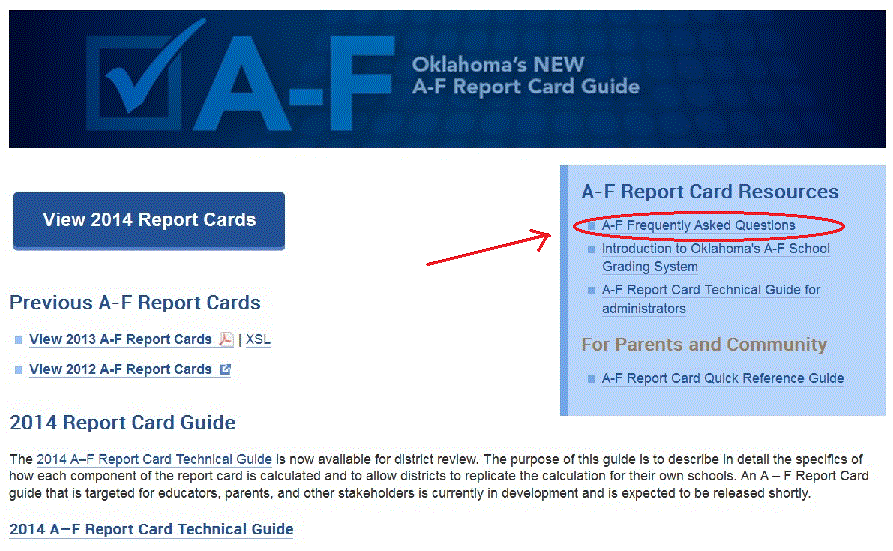
Note three things about this, keeping in mind the OKSDE chose the question, wrote the answer, and put it first on their own FAQ:
1. The A-F system is designed so parents and others can get a quick & easy idea how schools are doing. If you know anything about public education at all, you know that how we’re doing is anything but easy to measure. Half the time we can’t even agree about exactly what we should be doing. But the whole purpose of A-F, according to this, is to more conveniently label HOW SCHOOLS ARE DOING – minus context, nuance, causes, solutions, etc. This is repeated throughout the FAQ. Parents or community members could, of course, quickly and easily determine how local schools are doing by visiting and asking how it’s going, and what they could do to contribute – but that would be expecting someone outside the school itself to do something other than offer criticisms and blanket condemnations from afar.
2. The report card is a measurement “for challenging students and communities to strengthen the effectiveness and performance of public schools”. What does that mean, exactly? More importantly, now that we’ve done this a few times, what signs are there that each year with the A-F report cards come out, students rise up and communities mobilize to begin “strengthening” their schools? Does the SDE have even anecdotal evidence suggesting anything positive happens as a result of these press releases? If not, then by its own defintion the process is a failure and we can stop. If, on the other hand, students and communities are having montage moments over school effectiveness, then we should see very few schools on the ‘F’ list twice, yes?
3. The primary indication of success is standardized test scores. That’s a world of issues in and of itself.
Let’s look at another question from the FAQ:
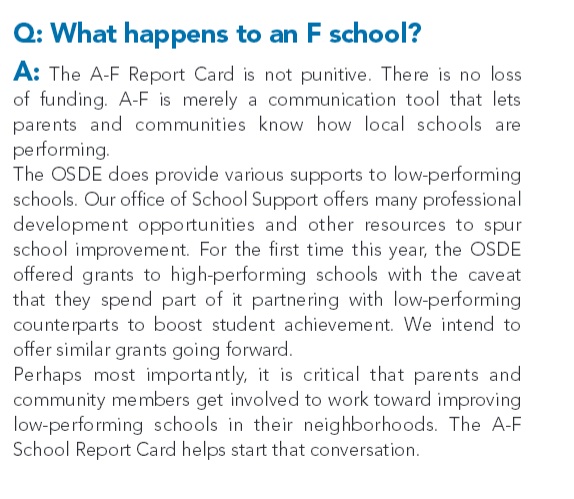
Wow. Where to begin?
4. Of course there’s a loss of funding. The state keeps cutting education budgets across the board. The only distinction is that they cut funding for all schools, not merely those labeled ‘D’ or ‘F’. This is the opposite of what a teacher – even a mediocre teacher – does with a student who’s trying, but not finding success. Imagine me bragging to a parent or administrator that although a specific child is in grade trouble, I’m not reducing the time and energy I spend trying to help her! Well – I am, but I’m reducing the time and energy I spend helping every other kid also, so let’s just pin on that Excellence Through Equity medal now!
5. If kids don’t hit those nebulous testing targets, we send in the REAL experts – the folks at the SDE – to educate the teachers. Of course the SDE has held the key to student success all along, but they’ve been keeping it super top secret to give those poor struggling teachers a chance to try it THEIR stupid way. Do we have any stats on the impact of this visit from the SDE on student test scores the FOLLOWING year? I mean, if the problem is that the teachers need some “spurring,” and the SDE’s done come and “spurred” them, scores should soar, yes?
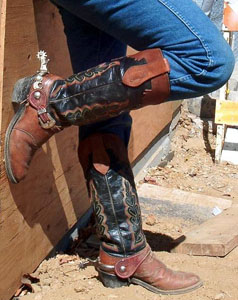 6. Can you tell the ‘spur’ thing bugs me? You spur a horse that’s not trying very hard or moving very fast. You spur a horse because horses are too stupid to know which way they’re supposed to go on their own. You dig your metal into its flank and keep your bit in its mouth so it will remain compliant – an extension of your own purposes. Spurring suggests schools and teachers get F’s because they’re just not trying very hard. They’re meandering, munching some grass, peeing a long time – just standing there until the SDE comes to do some spurrin’. Giddy-up go, Ms. Hernandez – giddy-up, go! Because you know what grade a horse really wants? A neighhhhh…
6. Can you tell the ‘spur’ thing bugs me? You spur a horse that’s not trying very hard or moving very fast. You spur a horse because horses are too stupid to know which way they’re supposed to go on their own. You dig your metal into its flank and keep your bit in its mouth so it will remain compliant – an extension of your own purposes. Spurring suggests schools and teachers get F’s because they’re just not trying very hard. They’re meandering, munching some grass, peeing a long time – just standing there until the SDE comes to do some spurrin’. Giddy-up go, Ms. Hernandez – giddy-up, go! Because you know what grade a horse really wants? A neighhhhh…
7. Choose any “low-performing school” near you. Give them a call and ask what the OKSDE has done to “support” them lately – or the state for that matter. Teachers are expected to address problem areas, find solutions, build success; all state leadership seems willing to do in practice is label and publish. Useless.
8. Grants to the good schools? I’d never heard of this one before. How adorable – it’s the White Man’s Burden, Education Edition. We’re going to further reward upper-middle-class-two-parent-family schools for explaining to the high-poverty-broken-world schools what they’re doing so badly! “Have you tried getting your kids to be less… poor? Are you familiar with the need for more ‘grit’?”
9. May I see the numbers on increased parent and community involvement based on low scores on this “report card”? Can I get in on this “conversation”? Dr. Barresi echoes this talking point in the Tulsa World when asked about the mass of research demonstrating the “grades” with which she bludgeons schools are not merely pointless, but demonstrably harmful and deceptive:
“The grade card may be cursed, it may be praised, but it sure is causing conversation in the state of Oklahoma,” Barresi said.
Adrian Peterson should try this approach: “Well, my disciplinary techniques may be cursed, or they may be praised, but they’re sure… (*patronizing chuckle*) causing conversation.”]
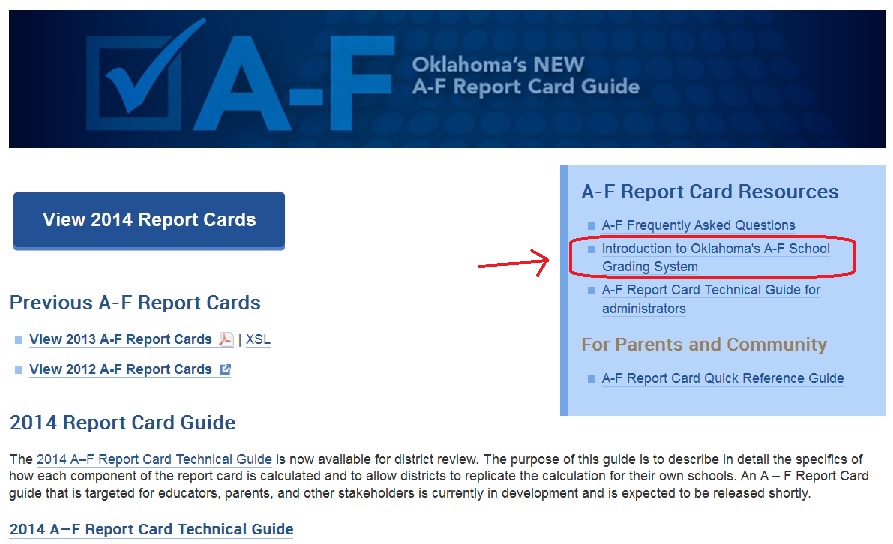
After this FAQ, the next item provided to explain the whole A-F system is this letter from the OKSDE’s own “Executive Director of Accountability.” He proceeds to contradict pretty much everything explained in the FAQ.

I’ll excerpt the essentials:
…we must ensure that the A-F system is both understandable and interpreted appropriately. Therefore, it is important to have a clear idea of what it is — and isn’t — intended to measure.
The A-F Report Card is:
* An indicator of the percentage of students, regardless of background, within a school who are currently meeting or exceeding grade-level academic standards.
* An indicator of the percentage of students (particularly the lower performing students) who are at least making significant progress toward meeting grade-level academic standards.
* An indicator of whether schools are exceeding expectations in terms of school attendance, high school graduation, etc…
The A-F Report Card is not:
* A measure of the “school” or “teacher” effect on student learning.
* A statement about a school’s overall quality of services provided.
10. I love his concern that we make A B C D & F somehow “understandable” and “interpreted appropriately.” The reason you choose to format something in terms of commonly recognized symbols and terms is because everyone recognizes those symbols and terms. Divide your class into reading groups christened Eagles, Sharks, Otters, and Turtles, and no one has to guess which group is the slow one. If the OKSDE were worried people might think that A B C D & F means what it obviously and always means, perhaps they could have chosen other terms.
11. Suddenly now this whole A-F thing is about measuring students – are students meeting expectations? Are students making progress? According to the rest of the OKSDE, the only part students have in this whole thing is when they rise up with the community to strengthen… something or other. But according to Dr. Tamborski and his fancy title, it’s all about the students. The only thing schools are directly responsible for is making sure every kid on their roster gets up and to school every day. I assume this involves setting their alarms, maybe pouring them a bowl of Fruit Loops, that kind of thing – stuff it makes complete sense to hold schools exclusively accountable for. Not this other stuff.
12. Lest we continue in our ridiculous delusions, we are explicitly corrected – WITH QUOTIE ACCENTS – not to view these A-F Report Cards as a measure of the “school” or “teacher”. Seriously – why is “school” in “quotation marks”? I’m not “sure” for what “purpose” they’re being “used” here. In any case, I’m confused. If these report cards don’t allow “parents and community members” to “quickly and easily determine how local schools are doing,” what exactly will the students, parents, and communities be rising up to encourage excellence and performance OF?
13. The A-F card is not a measure of “teacher” effect on student learning? This part I can actually believe, since there’s a whole slew of other mechanisms in place to blame teachers for every kid they so much as see in the hallway, for the rest of their lives. Unfortunately he didn’t tell THE ENTIRE REST OF THE OKSDE, the media, the state legislature, or the state. They think it is.
14. These Report Cards are not a statment regarding a school’s quality? Seriously, do these people not even talk to one another? The building isn’t that big.
Perhaps the third and final link for public consumption can act as a sort of “tie-breaker” between the OKSDE and the OKSDE. It’s not a FAQ or a letter, but something called a Quick Reference Guide. Perfect! I can use it to quickly reference what the hell they’re talking about.
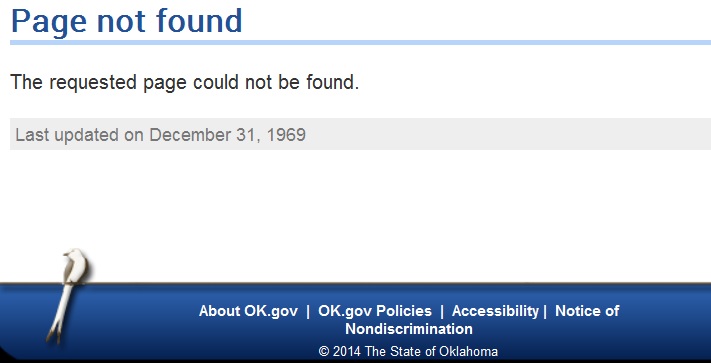
1969? What did one use to update web pages in 1969 – a hammer & chisel?
Well, OKSDE, if and when you get back from Woodstock or whatever, please consider reposting that reference guide. I can’t wait to see which side of your conflicting explanations it agrees with. In the meantime, I know I’m feeling much better about the accuracy and consistency of these A-F grades you’ve published now that I’ve seen the care and clarity you bring to explaining what they are and what they aren’t.
Related Post: Assessments & Grades – Why?

 The State of Oklahoma, like many others, is determined to assign numbers and letters to the schools and teachers within its purview. Like the standardized testing of students on which many of these numbers and letters are based, the conviction seems to be that if you just keep pretending to measure things in ridiculously oversimplified ways designed to guarantee widespread failure, you’re “reforming” the system and calling forth a brighter future for all. This is analogous to – actually, never mind the analogy. It’s just stupid.
The State of Oklahoma, like many others, is determined to assign numbers and letters to the schools and teachers within its purview. Like the standardized testing of students on which many of these numbers and letters are based, the conviction seems to be that if you just keep pretending to measure things in ridiculously oversimplified ways designed to guarantee widespread failure, you’re “reforming” the system and calling forth a brighter future for all. This is analogous to – actually, never mind the analogy. It’s just stupid.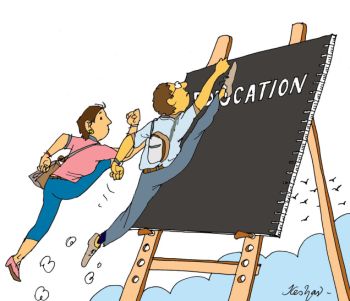 Summative Assessment is the other category. It’s the ‘BIG TEST’ at the end of a unit or a semester. These attempt to document what students “walk away with” in knowledge and skills. The data can identify strengths and weaknesses of individual teachers so we can help each other improve, or help compare classes from year to year. For students it’s generally the finish line, for better or worse – here’s how you did, now off with thee.
Summative Assessment is the other category. It’s the ‘BIG TEST’ at the end of a unit or a semester. These attempt to document what students “walk away with” in knowledge and skills. The data can identify strengths and weaknesses of individual teachers so we can help each other improve, or help compare classes from year to year. For students it’s generally the finish line, for better or worse – here’s how you did, now off with thee. The A-F Report Card given by the State of Oklahoma to its public schools each year does none of the things assessment is supposed to do. It provides no support, and intentionally limits the data it is willing to consider. There are no adjustments on the part of the state based on how well a given school is doing, and no conversation regarding options for improvement. It’s not even measuring most of the things we claim are most valuable to us. It is merely calculated and published, and each year more and more schools are sent to sit in the corner with their ‘dunce’ caps on.
The A-F Report Card given by the State of Oklahoma to its public schools each year does none of the things assessment is supposed to do. It provides no support, and intentionally limits the data it is willing to consider. There are no adjustments on the part of the state based on how well a given school is doing, and no conversation regarding options for improvement. It’s not even measuring most of the things we claim are most valuable to us. It is merely calculated and published, and each year more and more schools are sent to sit in the corner with their ‘dunce’ caps on.